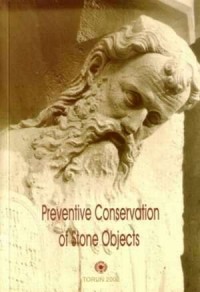Tytuł książki:
Preventive conservation of stone historical objects
Autor książki:
Wiesław Domasłowski
(red.)
| Dane szczegółowe: | |
| Wydawca: | Uniwersytet Mikołaja Kopernika |
| Rok wyd.: | 2003 |
| Oprawa: | miękka |
| Ilość stron: | 244 s. |
| Wymiar: | 160x230 mm |
| EAN: | 9788323116455 |
| ISBN: | 83-231-1645-8 |
| Data: | 2001-01-28 |
Cena wydawcy: 31.00 złpozycja niedostępna
×
Opis książki:
This publication is intended as a manual for students who specialize in restoration of stone historical objects. It is complementary to lecture materials delivered to the students of the second year, after they have got acquainted with the bases of chemistry, physics, geology and petrography. Fundamental knowledge of these subjects makes it possible to understand and get to know the information material contained in the present book.
Książka "Preventive conservation of stone historical objects" - Wiesław Domasłowski (red.) - oprawa miękka - Wydawnictwo Uniwersytet Mikołaja Kopernika. Książka posiada 244 stron i została wydana w 2003 r.
Spis treści:
Introduction (W. Domasłowski); The resistance of rocks to the action of destructive agents and symptoms of deterioration (W. Domasłowski): * Igneous rocks * Sedimentary rocks - sandstones * Sedimentary rocks - limstones and marbles; Causes of stone deterioration (W. Domasłowski): The action of water * The action of atmospherical gases and pollution * The action of water-soluble-salts * Effect of temperature changes * The action of mechanical agents; Biological factors (S. Leźnicka): The role of autotrophic microorganisms in stone deterioration * Algae, blue-green algae and lichens * Chemolithotrophic bacteria * Sulphuric bacteria and reducing sulphuric compounds * Nitrifying bacteria * Higher plants on stone historical objects * The role of heterotrophic organisms in deterioration of stone objects * Moulds * Heterotrophic bacteria; Patina - the mechanism of formation and properties (W. Domasłowski); Pre-investigation of stone historical objects (M. Rudy): Evaluation of the state of preservation * Petrographic investigation of stone * Investigation of deposits (M. Kęsy-Lewandowska) * Investigation of paint layers * Investigation of water-soluble-salts (S. Skibiński) * Sampling of salt-contaminated stone * Salt extraction from stone * Evaluation of salt percentage in stone * By weight * By conductometry * Investigation of microorganisms * Evaluation of moisture content * Investigation of mortars and artificial stone * Evaluation of physico-mechanical properties of stone * Capillary properties of stone * Examination with a measuring pipe * Examination of the rate of capillary liquid suction * Drying capacity * Specific and apparent density of stone * Water absorption capacity of stone * Mechanical strength of stone * Non-destructive methods of investigation of stone historical objects (E. Derkowska-Rybicka) * Mechanical methods * Acoustic methods * Electromagnetic methods * Nuclear methods; 6. The methods for preventive conservation of stone monuments: The introductory steps of conservation (J. W. Łukaszewicz) * The preservation of polychromy (M. Rudy) * Removal of surface deposit (W. Domasłowski, D. Kwiatkowski) * The mechanical removal of deposits * Hammering of stones * Abrasion of deposits * The deposit removal by means of brushes * Sandblasting for deposit removal * Deposit removal by heating * Deposit removal by self-peeling * Deposit removal by means of ultrasounds * Some physico-chemical and chemical methods for deposit removal * Deposit removal by means of organic solvents * Deposit removal by means of water * Deposit removal by means of steam * Deposit removal by means of water solution of salts * Deposit removal by means of alkalies * Deposit removal by means of acids * Removal of oil over-paintings * Oil over-paintings removal by means of organic solvents * Oil over-paintings removal by saponification * Desalination of stones (J. Krause, B. Soldenhoff) * Some problems related to the desalination of stone monuments * Desalination compresses * The methods for desalination of monuments * Desalination by migration of salts to the open environment * The method of free migration of salts to the open environment * The forced migration of salts to the open environment * Desalination under the column of water * Desalination under vacuum * Desalination by diffusion of salts * Desalination in a static bath * Desalination in a dynamic bath * Desalination by means of constant electric field (S. Skibiński) * The methods for limitation of salts crystallization (W. Domasłowski) * Transformation of sulphates into insoluble salts * Limitation of free crystallization and migration of salts * The destruction of living organisms (A. Strzelczyk) * Dehydration treatments inhibiting the growth of microorganisms * Chemical treatments * Destruction of microorganisms (bacteria, fungi, algae and lichens) * The removal of fungi originated stains from stone monuments * Protection against water (D. Sobkowiak) * Drying and stabilization of the ground * Horizontal drainage * Vertical drainage * Electrodrainage * Cebertisation * Prevention the capillary rising of water in stone monuments * Horizontal and vertical insulation * Electroosmotic insulation * Insulation based on chemical methods * Introduction of substances blocking water capillary rising * Materials for anti-capillary barriers * The methods of monument protection against moistening * Drying by the Knappen method * Pointing with porous mortars * Drying of stone above insulation * The hydrophobisation of stone (W. Domasłowski, O. Kazanecka) * Surface phenomena * Surface tension of liquid * Wetting of solids by liquids * Terminal contact angle * Capillary rising of liquids * Some properties of water-repellent substances * Soaps * Waxes * Natural waxes * Synthetic waxes * Synthetic resins * Organo-silicon compounds - silicones (J. W. Łukaszewicz) * Basic oragnosilicon compounds * Chemical transformation of silanes * Hardening of organo-silicon compounds * Water-repellent properties of silicon layers * The methods of hydrophobisation by means of silicones * Commercially available products for stone conservation * The practical use of water-repellent substances for protection of monuments * The protection of stones against atmospheric gases (W. Domasłowski); Bibliography

